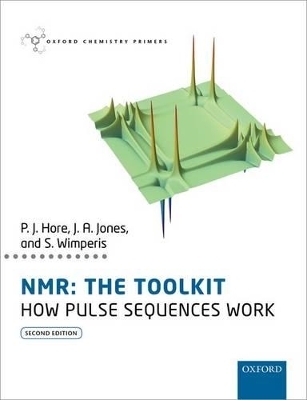
NMR: The Toolkit
How Pulse Sequences Work
Seiten
2015
|
2nd Revised edition
Oxford University Press (Verlag)
978-0-19-870342-6 (ISBN)
Oxford University Press (Verlag)
978-0-19-870342-6 (ISBN)
This primer describes succinctly the range of NMR techniques commonly used in modern research, and explains how these experiments actually work, giving a unique perspective on this powerful experimental tool.
The renowned Oxford Chemistry Primer series, which provides focused introductions to a range of important topics in chemistry, has been refreshed and updated to suit the needs of today's students, lecturers, and postgraduate researchers. The rigorous, yet accessible, treatment of each subject area is ideal for those wanting a primer in a given topic to prepare them for more advanced study or research. Moreover, cutting-edge examples and applications throughout the texts show the relevance of the chemistry being described to current research and industry.
The learning features provided, including questions at the end of every chapter and online multiple-choice questions, encourage active learning and promote understanding. Furthermore, frequent diagrams, margin notes, further reading, and glossary definitions all help to enhance a student's understanding of these essential areas of chemistry.
NMR: The Toolkit describes succinctly the range of NMR techniques commonly used in modern research to probe the structures and properties of molecules in liquids. Emphasis is placed throughout on how these experiments actually work, giving a unique perspective on this powerful experimental tool.
Online Resource Centre
The Online Resource Centre to accompany NMR The Toolkit: How Pulse Sequences Work features:
For registered adopters of the text:
· Figures from the book available to download
For students:
· Full worked solutions to the end-of-chapter exercises
The renowned Oxford Chemistry Primer series, which provides focused introductions to a range of important topics in chemistry, has been refreshed and updated to suit the needs of today's students, lecturers, and postgraduate researchers. The rigorous, yet accessible, treatment of each subject area is ideal for those wanting a primer in a given topic to prepare them for more advanced study or research. Moreover, cutting-edge examples and applications throughout the texts show the relevance of the chemistry being described to current research and industry.
The learning features provided, including questions at the end of every chapter and online multiple-choice questions, encourage active learning and promote understanding. Furthermore, frequent diagrams, margin notes, further reading, and glossary definitions all help to enhance a student's understanding of these essential areas of chemistry.
NMR: The Toolkit describes succinctly the range of NMR techniques commonly used in modern research to probe the structures and properties of molecules in liquids. Emphasis is placed throughout on how these experiments actually work, giving a unique perspective on this powerful experimental tool.
Online Resource Centre
The Online Resource Centre to accompany NMR The Toolkit: How Pulse Sequences Work features:
For registered adopters of the text:
· Figures from the book available to download
For students:
· Full worked solutions to the end-of-chapter exercises
Peter Hore is Professor of Chemistry at the University of Oxford. Jonathan Jones is Head of Teaching in the Department of Physics at the University of Oxford. Stephen Wimperis is Professor of Magnetic Resonance at the University of Glasgow.
PART A: PRODUCT OPERATORS; PART B: QUANTUM MECHANICS
| Erscheint lt. Verlag | 4.6.2015 |
|---|---|
| Reihe/Serie | Oxford Chemistry Primers |
| Verlagsort | Oxford |
| Sprache | englisch |
| Maße | 190 x 247 mm |
| Gewicht | 238 g |
| Themenwelt | Naturwissenschaften ► Chemie ► Analytische Chemie |
| Naturwissenschaften ► Chemie ► Physikalische Chemie | |
| ISBN-10 | 0-19-870342-2 / 0198703422 |
| ISBN-13 | 978-0-19-870342-6 / 9780198703426 |
| Zustand | Neuware |
| Haben Sie eine Frage zum Produkt? |
Mehr entdecken
aus dem Bereich
aus dem Bereich


